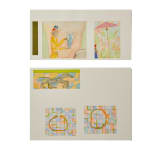Areez Katki b. 1989
Treasury, 2023
Watercolour on Arches cotton paper
(HSN Code: 970110)
(HSN Code: 970110)
Top: 5.9 x 11.81 inches
Bottom: 11.69 x 8.26 inches
Diptych
Bottom: 11.69 x 8.26 inches
Diptych
Copyright Areez Katki, 2023
This series of nine diptych works on paper are based on a reframing of archaeological material from the vantage point of the Parsi queer diaspora. The process began with an...
This series of nine diptych works on paper are based on a reframing of archaeological material from the vantage point of the Parsi queer diaspora. The process began with an exploration of archives—beginning from a broad range—that contained artifacts from Achaemenid Persia, particularly those which were excavated by European archaeological teams from the 19th and early-20th centuries. Most of these objects were taken to Europe and several are still at the Musée du Louvre in Paris; some are from the Oxus Treasure, which is a large finding of gold and precious metal-based Achaemenid findings, which are still at the British Museum; and a select few artifacts and architectural motifs cited in this series are from the National Museum of Iran (Tehran) and the present-day ruins of Persepolis (located in the Fars province of present-day Iran), which was destroyed by Alexander of Macedon in 330 BC.
Over the past seven years Katki has closely studied what remains of Achaemenid art: alongside these studies he has practiced the queer art of fabulation, through cues provided in elements of tangible narrative that are traceable in Zoroastrian decorative motifs, domestic and ceremonial artifacts, and the structural plans of Persepolis which has been repeatedly visited by him since his first field trip there in 2018.
The Achaemenid empire was the largest one of its kind at its time: between 550 – 330 BCE the proliferation of art, culture and edicts of human rights testified great advancements made by humankind that remained unparallel for two centuries across much of SWANA, Asia and Europe. This panel delves into two very contrasting histories that suggest a completely fantasized landscape and lifestyle from the vantage point of a queer descendant who no longer has access to nor claim to anything but the ephemeral and affective qualities of a Persian identity. The smaller top panel depicts two cropped scenes—one of a courtier carrying a brimming amphora of milk behind a donkey, and an imperial scene of Darius (cropped almost completely) under his pink parasol: both, the brimming of milk and the pinkness of the parasol—along with other chromatic and compositional elements—are liberties taken from an exiled imagination that queers their own history, to reimagine the absurd opulence and campness of a lost empire; not necessarily celebrating it but rather positing questions around representation when most access is curtailed. The larger lower panel depicts a reanimated duo of horses mid-gallop, based on a silver figurine from the Oxus Treasure, looted by British archaeologists. Below are two gold lion-headed bracelets—looted by French archaeologists—painted against a watery pastel ground—suggesting the imagined textiles woven and adorning rooms in Persepolis. (Note: all three objects still lay on display at the British Museum and the Louvre, respectively.)
Over the past seven years Katki has closely studied what remains of Achaemenid art: alongside these studies he has practiced the queer art of fabulation, through cues provided in elements of tangible narrative that are traceable in Zoroastrian decorative motifs, domestic and ceremonial artifacts, and the structural plans of Persepolis which has been repeatedly visited by him since his first field trip there in 2018.
The Achaemenid empire was the largest one of its kind at its time: between 550 – 330 BCE the proliferation of art, culture and edicts of human rights testified great advancements made by humankind that remained unparallel for two centuries across much of SWANA, Asia and Europe. This panel delves into two very contrasting histories that suggest a completely fantasized landscape and lifestyle from the vantage point of a queer descendant who no longer has access to nor claim to anything but the ephemeral and affective qualities of a Persian identity. The smaller top panel depicts two cropped scenes—one of a courtier carrying a brimming amphora of milk behind a donkey, and an imperial scene of Darius (cropped almost completely) under his pink parasol: both, the brimming of milk and the pinkness of the parasol—along with other chromatic and compositional elements—are liberties taken from an exiled imagination that queers their own history, to reimagine the absurd opulence and campness of a lost empire; not necessarily celebrating it but rather positing questions around representation when most access is curtailed. The larger lower panel depicts a reanimated duo of horses mid-gallop, based on a silver figurine from the Oxus Treasure, looted by British archaeologists. Below are two gold lion-headed bracelets—looted by French archaeologists—painted against a watery pastel ground—suggesting the imagined textiles woven and adorning rooms in Persepolis. (Note: all three objects still lay on display at the British Museum and the Louvre, respectively.)
Join our mailing list
* denotes required fields
We will process the personal data you have supplied in accordance with our privacy policy (available on request). You can unsubscribe or change your preferences at any time by clicking the link in our emails.



